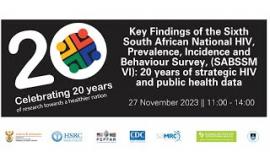
Out of the nine provinces in South Africa, the Western Cape had the lowest HIV prevalence (7.4%) in 2022 and second lowest in 2017 (8.6%).
According to the Human Sciences Research Council (HSRC), this translates to 540 000 people living with HIV (PLHIV) in the Western Cape, which was a decline from 560 000 PLHIV in 2017.
The information is based on the findings of the Sixth South African HIV Prevalence, Incidence and Behaviour Survey (SABSSM VI) for the Western Cape, which was released by the HSRC on Thursday.
According to the overall principal investigator of the study, the HSRC’s Professor Khangelani Zuma, the survey showed that in 2022, HIV prevalence in the province was higher among those aged 25 to 49 (10.8%) for both females (14.6%) and males (5.8%).
Meanwhile, HIV prevalence was higher among females (9%) compared to males (5.6%).
“HIV prevalence peaked at 12.9% amongst those aged 35 to 39 in 2022 from 23.4% in 2017 within the same age group.
“There was a decrease in HIV prevalence in 2022 among all age groups younger than 30 to 34 years compared to 2017, apart from the age groups zero to 14; 15 to 19, and those 50 years and older.
“The worsening prevalence among those younger than 24 years is deeply concerning, as it shows continued new infections from both horizontal and vertical transmissions,” Zuma said.
SAnews reported last week that Mpumalanga now has the highest HIV prevalence at 17.4% in 2022, which translates to an estimated 890 000 (PLHIV) in the province, followed by KwaZulu-Natal.
READ | Mpumalanga records highest HIV prevalence rate
Antiretroviral treatment
Antiretroviral treatment (ART) coverage in the Western Cape increased to 76.8% in 2022, from 54.4% in 2017.
This translates to an estimated 360 000 PLHIV in the province receiving ART in 2022.
In 2022, ART use among all PLHIV in the province was lower among those aged 15 to 49 (76.5%) compared to other age groups.
ART use was also lower among males (75.3%) compared to females (77.1%).
In addition, ART use was 76.2% amongst respondents who reside in urban areas and 81.4% in the City of Cape Town.
The SABSSM VI survey, conducted between 2022 and 2023, aimed to maintain surveillance of HIV infection and behaviours in South Africa, evaluate the progress of the South African national HIV and Aids, STI and TB Strategic Plan, and monitor HIV indicators for national and international reporting.
Viral load suppression (VLS)
The survey further revealed that in 2022, among all provinces, the Western Cape had the seventh highest proportion of PLHIV with VLS (78.4%), having increased from 2017 (54.6%).
Overall, VLS was also lower among males (76%) compared to females (79.7%).
VLS was also lower among those aged 50 and older (69.4%) compared to other age groups.
Knowledge of HIV status
The professor expressed concern that PLHIV between 25 and 49 years accounted for the majority of PLHIV in the Western Cape, who were unaware of their HIV status (59.1%); aware but not on ART (64.7%), and on ART but not VLS (66.7%).
Adolescents and youth aged between 15 and 24 contributed disproportionally to gaps in treatment, accounting for just 9.5% of all PLHIV.
Regarding the key drivers of the HIV epidemic, Zuma noted that in the Western Cape, there was an increase in the proportion of adolescents and youth aged 15 to 24, who reported sex before the age of 15 in 2017 (14%), compared to 2022 (16.3%).
Sexual debut before the age of 15 among adolescents and youth aged 15 to 24 in 2022 was higher among males (21.5%) than females (11.3%).
Multiple sexual partners
The survey revealed that in the Western Cape, 6.7% of people aged 15 and older reported having two or more sexual partners in 2022 compared to 7.6% in 2017.
The proportion of people aged 15 and older who reported having multiple sexual partners was two-fold higher among males (8.9%), compared to females (4.4%), and higher among those aged 15 to 24 (19.1%) compared to other age groups.
Condom use
The survey revealed that 22.1% reported using a condom with their most recent sexual partner in 2022 compared to 26.6% in 2017, representing a 4.5% decline.
Condom use with their most recent sexual partner among people who are 15 years and older was higher among those 15 to 24 years (39.9%) and in the urban areas (22.5%), while it was similar by sex.
A higher proportion also reported that they had never or sometimes (81.4%) used a condom with their most recent sexual partner. Only 13.4% reported that they had used condoms almost every time.
Consistency of condom use with their most recent sexual partner among people aged 15 in the province was higher among youth aged 15 to 24 (24%). – SAnews.gov.za


